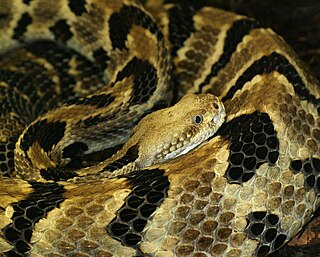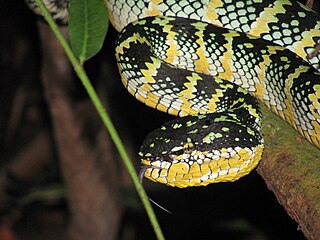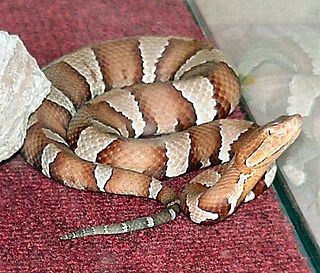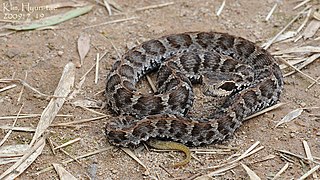
Agkistrodon contortrix is a species of venomous snake, a pit viper, endemic to Eastern North America; it is a member of the subfamily Crotalinae in the family Viperidae. The common name for this species is the eastern copperhead. The generic name is derived from the Greek words ancistro (hooked) and odon (tooth), or fishhook. The trivial name, or specific epithet, comes from the Latin contortus ; which is usually interpreted to reference the distorted pattern of darker bands across the snakes back, which are broad at the lateral base but "pinched" into narrow hourglass shapes in the middle at the vertebral area. Five subspecies have been recognized in the past, but recent genetic analysis shows that A. contortrix and two of the subspecies are monotypic, while Agkistrodon laticinctus and the fifth subspecies are a single distinct species.

Agkistrodon piscivorus is a species of pit viper in the subfamily Crotalinae of the family Viperidae. It is the world's only semiaquatic viper, and is native to the southeastern United States. It is the only venomous species of North America's water snakes and one of 21 venomous snakes in the United States. As an adult, it is large and capable of delivering a painful and potentially fatal bite. When threatened, it may respond by coiling its body and displaying its fangs. Individuals may bite when feeling threatened or being handled in any way. It occurs in or near water, particularly in slow-moving and shallow lakes, streams, and marshes. It is a strong swimmer and has even been seen swimming in the ocean. However, it is not fully marine, unlike true sea snakes. It has successfully colonized islands off both the Atlantic and Gulf coasts.

The Crotalinae, commonly known as pit vipers, crotaline snakes, or pit adders, are a subfamily of venomous vipers found in Eurasia and the Americas. They are distinguished by the presence of a heat-sensing pit organ located between the eye and the nostril on both sides of the head. Currently, 22 genera and 151 species are recognized: These are also the only viperids found in the Americas. The groups of snakes represented here include rattlesnakes, lanceheads, and Asian pit vipers. The type genus for this subfamily is Crotalus, of which the type species is the timber rattlesnake, C. horridus.

Agkistrodon is a genus of venomous pit vipers found in Americas from the United States south to northern Costa Rica. Eight species are currently recognized, all of them monotypic and closely related. Common names include: cottonmouths, copperheads, and cantils. Some varieties are known as "moccasins" or "moccasin snakes", such as Agkistrodon piscivorus, the water moccasin.

Metlapilcoatlus is a genus of venomous pit vipers endemic to Mexico and Central America. Five species are currently recognized. The common names suggest they are able to leap at an attacker, but this is likely exaggerated. Common names for the species include jumping pitvipers and jumping vipers.

Gloydius is a genus of venomous pitvipers endemic to Asia, also known as Asian moccasins or Asian ground pit vipers. Named after American herpetologist Howard K. Gloyd, this genus is very similar to the North American genus Agkistrodon. 22 species are currently recognized.

Bothriechis schlegelii, known commonly as the eyelash viper, is a species of venomous pit viper in the family Viperidae. The species is native to Central and South America. Small and arboreal, this species is characterized by a wide array of color variations, as well as the superciliary scales above the eyes. It is the most common of the green palm-pitvipers, and is often present in zoological exhibits. The specific name schlegelii honors Hermann Schlegel, who was a German ornithologist and herpetologist. For other common names see below. No subspecies are currently recognized as being valid.

Tropidolaemus is a genus of venomous pit vipers found in southern India and Southeast Asia. Currently, 5 species are recognised and no subspecies.

Deinagkistrodon is a monotypic genus created for the venomous pit viper species, D. acutus, which is endemic to Southeast Asia. No subspecies are currently recognized.

Agkistrodon piscivorus leucostoma is a venomous snake that is endemic to the south central United States. A member of the subfamily Crotalinae of the family Viperidae, it is the smallest of the three subspecies of Agkistrodon piscivorus.

Agkistrodon taylori is a venomous pitviper species found only in northeastern Mexico. It is named in honor of American herpetologist Edward Harrison Taylor.

Gloydius blomhoffii, commonly known as the mamushi, Japanese moccasin, Japanese pit viper, Qichun snake, Salmusa or Japanese mamushi, is a venomous pit viper species found in China, Japan, and Korea. There are four subspecies including the nominate subspecies described here.

Agkistrodon bilineatus is a highly venomous pit viper species found in Mexico and Central America as far south as Honduras.

Agkistrodon piscivorus conanti, commonly known as the Florida cottonmouth or green-tailed moccasin, is a venomous pitviper subspecies in the family Viperidae. The subspecies is found in the southeastern United States, particularly in Florida.

Agkistrodon contortrix pictigaster is a venomous pit viper subspecies found in the Trans-Pecos region of the United States in western Texas, and northeastern Mexico.
Thunder snake may refer to:

Agkistrodon contortrix mokasen is a venomous pit viper subspecies found in the eastern United States.

Agkistrodon contortrix phaeogaster is a venomous pit viper subspecies found in the central region of the United States.
Agkistrodon howardgloydi is a species of pit viper, a venomous snake in the subfamily Crotalinae in the family Viperidae. The subspecies is endemic to Central America.

Gloydius brevicaudus is a venomous pitviper subspecies endemic to China and the Korean Peninsula.

















